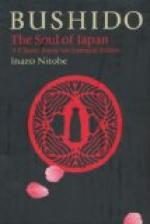In the Bushido ideal of woman, however, there is little mystery and only a seeming paradox. I have said that it was Amazonian, but that is only half the truth. Ideographically the Chinese represent wife by a woman holding a broom—certainly not to brandish it offensively or defensively against her conjugal ally, neither for witchcraft, but for the more harmless uses for which the besom was first invented—the idea involved being thus not less homely than the etymological derivation of the English wife (weaver) and daughter (duhitar, milkmaid). Without confining the sphere of woman’s activity to Kueche, Kirche, Kinder, as the present German Kaiser is said to do, the Bushido ideal of womanhood was preeminently domestic. These seeming contradictions—Domesticity and Amazonian traits—are not inconsistent with the Precepts of Knighthood, as we shall see.
Bushido being a teaching primarily intended for the masculine sex, the virtues it prized in woman were naturally far from being distinctly feminine. Winckelmann remarks that “the supreme beauty of Greek art is rather male than female,” and Lecky adds that it was true in the moral conception of the Greeks as in their art. Bushido similarly praised those women most “who emancipated themselves from the frailty of their sex and displayed an heroic fortitude worthy of the strongest and the bravest of men."[24] Young girls therefore, were trained to repress their feelings, to indurate their nerves, to manipulate weapons,—especially the long-handled sword called nagi-nata, so as to be able to hold their own against unexpected odds. Yet the primary motive for exercises of this martial character was not for use in the field; it was twofold—personal and domestic. Woman owning no suzerain of her own, formed her own bodyguard. With her weapon she guarded her personal sanctity with as much zeal as her husband did his master’s. The domestic utility of her warlike training was in the education of her sons, as we shall see later.
[Footnote 24: Lecky, History of European Morals II, p. 383.]
Fencing and similar exercises, if rarely of practical use, were a wholesome counterbalance to the otherwise sedentary habits of woman. But these exercises were not followed only for hygienic purposes. They could be turned into use in times of need. Girls, when they reached womanhood, were presented with dirks (kai-ken, pocket poniards), which might be directed to the bosom of their assailants, or, if advisable, to their own. The latter was very often the case: and yet I will not judge them severely. Even the Christian conscience with its horror of self-immolation, will not be harsh with them, seeing Pelagia and Domnina, two suicides, were canonized for their purity and piety. When a Japanese Virginia saw her chastity menaced, she did not wait for her father’s dagger. Her own weapon lay always in her bosom. It was a disgrace to her not to know the proper way in which




